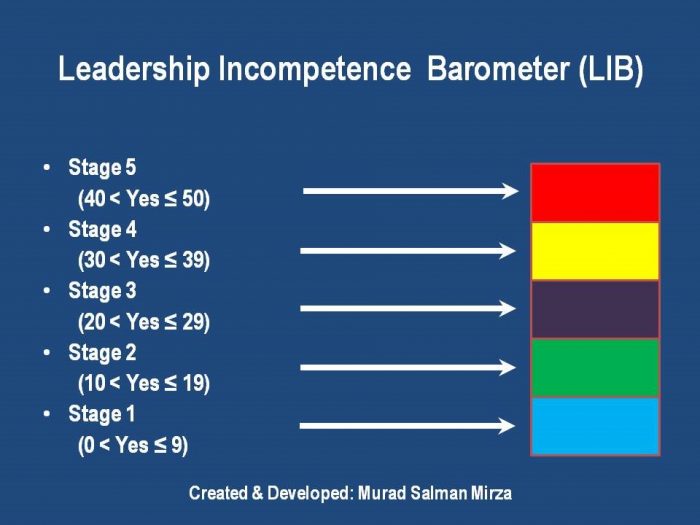(A Pragmatic Approach for Identifying Leadership Incompetence in the Digital Age)
Management literature is generally dedicated to defining/describing/devising/deliberating leadership in terms of the ‘desirable’ traits that are necessary for incumbents and future aspirants to successfully steer their organizations through the challenging dynamics of an evolving market, especially, in the Digital Age. However, such a ‘positively-skewed’ approach often fails to adequately capture the various warning signs that are flashed by the corporate leaders to indicate their lack of ability to hold the top position within the organizational hierarchy. Consequently, the focus of the ‘corporate stewards’, e.g., Board of Directors/Trustees, HR/Talent Management Heads, Regulatory/Monitoring Bodies, etc., remains ‘tilted’ towards the propounding/preaching of the ingraining/inculcation of the ‘desired’ traits within the current and future corporate leadership, rather than, assuring and ensuring a balanced approach that also advocates the elimination of the ‘undesirable traits’ in a systematic and concurrent fashion.
This often results in the presence of a ‘deeply flawed’ leadership that tends to retain its ‘regressive’ traits while piling upon ‘progressive’ attributes to satisfy the ‘expectations’ for attaining/sustaining the top office within the organization. Examples in the respective context include; a resolute focus on achieving shareholder profitability at the expense of perpetuating a toxic/cannibalistic work environment that disregards health and wellbeing of the workforce, incentivizing the achievement of desired goals by institutionalizing the principle of ‘bending the rules without breaking them’ among ambitious team members as a form of innovation, utilizing ‘golden handcuffs’ to restrain capable talent from seeking promising opportunities elsewhere in a timely manner, encouraging the ‘cult’ of leadership that projects a regimented form of ‘organizational bonding’ as a key ‘career progression’ trait for opportunistic professionals, becoming an evangelist for progressive corporate values without adhering to them personally, etc.
The following collection of various aspects of personality disposition address the aforementioned incongruity by providing astute insights into realizing and ascertaining the gravity of the inherent shortcomings to facilitate a more equitable formulation of professional attributes within the corporate leadership:
- Refusing to listen to mumblings/rumblings within the organization and concentrating exclusively on the outside business environment
- Lethargy/Complacency/Hesitancy in taking progressive decisions
- Inability to evolve from an “I know best” attitude
- Living in a ‘bubble’ where everything is tuned/projected to be fine by ingratiating sycophants
- Inability to identify the ‘true’ stakeholders and failing to timely and effectively cater to their needs & expectations
- Protecting the ‘underperforming sycophants’ and disciplining the ‘productive rebels’ in the workforce
- Leading with unbridled powers and minimal accountabilies
- Institionalizing divisive measures (e.g., facilitating/fomenting the grapevine/rumor mill, fostering/permeating the ‘Divide & Rule’ policy, favoring nepotism over competence, etc.) to govern a fragmented workforce
- Dismissing/Ignoring the profound strengths of the astute competitors due to the current dominant market position of his/her own organization and/or devising ineffective/rudimentary strategies to meet their rising challenges
- Living in the Past or being content with the Present without planning for the Future
- Excessive focus on personal career growth/preservation, rather than, striving for an enduring positive legacy
- Ignoring the ‘Human Factor’ and putting ‘all the eggs’ in the ‘Technology’ basket
- Prone to fad-surfing, rather than, inculcating effective strategies that ‘actually matter’ in the context of the effective functioning of the organization
- Being an active contributor to the corporate grapevine
- Being unreliable in ‘action’ and reliable in ‘inaction’
- Inability to develop capable future leaders for the organization
- Tendency to rely on ‘one side of the picture’ for comprehending the issue(s) at hand
- Inability to admit mistakes and/or take responsibility for the wrong decisions
- Prioritizing ‘pet projects’ at the expense of compromising strategic imperatives for the organization
- Failing to appreciate and timely pivot with respect to the changing ecosystem of the organization’s industry
- Starting multiple ‘change’ initiatives without developing a clear picture of a ‘successful’ outcome
- Taking business risks without a robust risk management plan
- Basking in self-adulation while ignoring the valuable contributions of team members
- Failing to mobilize and optimize the available resources in a timely, efficient and effective manner
- Seeking alliances with wily competitors on areas where his/her own organization has strengths, rather than, concentrating on and overcoming the inherent weak areas
- Failing to capitalize on promising business opportunities primarily due to a conservative/risk-averse disposition
- Penchant for seeking/soliciting short-term wins, rather than, maneuvering/strategizing for long-term gains
- Failing to curb/address metastasized discontent within the organization
- Deploying machiavellian tactics to neutralize/suppress the rightful demands of the unions
- Being indifferent to the huge gap between the compensation packages of the top/senior management and the ones provided to the workforce at other levels of the organizational hierarchy
- Utilizing Diversity and Inclusion initiatives as a ‘marketing’ exercise, rather than, as a catalyst for driving innovation and for assuring organizational effectiveness
- Preferring the voice of the ‘conformists’ over the ‘rebels’ in terms of listening to the opinions/perspectives/insights pertaining to institutionalizing/ingraining/implementing transformative measures
- Utlizing technology as a ‘communication buffer’ to avoid answering/addressing difficult/uncomfortable questions from the workforce in face-to-face settings
- Treating ‘wasteful’ activities as a necessary ‘cost’ of doing business, rather than, investing in more ‘value-added’ measures in accordance with ‘lean’ principles
- Maintaining an adversarial relationship with the regulators
- Usurping credit for the achievements of his/her team members and projecting the image of a ‘solo’ player driving a flock of submissive sheep who are not capable of being ‘trusted’ with empowerment
- Adorning a frown/stern expression or wearing a mischievous smirk instead of a genuine simle on his/her face as a mark of superior standing and privilege
- Preferring to keep a distance from employees during corporate social engagements
- Treating Reward and Recognition of team members as cumbersome ‘burdens’ of his/her job
- Considering mentoring a waste of time and effort in grooming upcoming talent within the organization
- Proclivity for surrounding himself/herself with ingratiating sycophants, rather than, capable team members who are empowered to express their views independently without fear of reprisals
- Preferring to talk more, especially, on subjects that are not his/her expertise
- Preferring to listen less to expert advice that is driven by factual information and relying on more of the ‘gut feeling’ that is driven by personal instinct
- Preferring to seek ‘confirmation bias’ in terms of hearing/seeing more of what appreals to him/her to take important decisions
- Ruling by a ‘raging’ ego that clouds sound judgement in formulating optimal solutions to prevailing corporate challenges
- Demanding ‘personal loyalty’ over ‘corporate citizenship’ from hapless/subservient team members
- Penchant for bowing to the ‘demands’ of the activist shareholders in executive decision-making, rather than, astutely engaging all the key stakeholders in the best interest of the organization
- Inability to extricate himself/herself from micro-management, especially, due to distrust of the other levels of management in terms of the ability to do their jobs
- Spending the majority of time ‘outside’ the organization, rather than, ‘inside’ the organization
- Failing to timely and effectively address/allay a sense of forebording sweeping throughout the organization during precarious economic times
The severity of the incompetence rises in proportion to the number of aspects that match the leader being assessed on the aforementioned parameters. This can be visualized by utilizing the following criteria and projecting it onto the subsequent chart:
Stage Interpretation:
Stage 5 (Clear and Present Danger to Corporate Survival/Needs Immediate Replacement)
Stage 4 (Habitual and Unconscionable Offender/Requires Timely and Effective Intervention)
Stage 3 (Actively Favoring the Machiavellian Approach/Courting the ‘Dark’ Side)
Stage 2 (Frequently Crossing the Line/Propensity for Transgressions)
Stage 1 (Prone to Occasional Misstep/Humanly Imperfect)

The aforementioned approach assures and ensures a timely heads-up in terms of adjusting the course of an organization’s jeopardized future by taking effective measures for improving the quality of leadership in a balanced manner. It also serves as a vivid reminder for prudently navigating the path for developing future leaders to avoid falling into the trap of a skewed emphasis on only the ‘goodness’ of leadership for cultivating ‘angelic’ leaders. No human is infallible and capable leaders are not an exception in the respective context. They just have a finer control of their devilish proclivities. Are you one of them?









